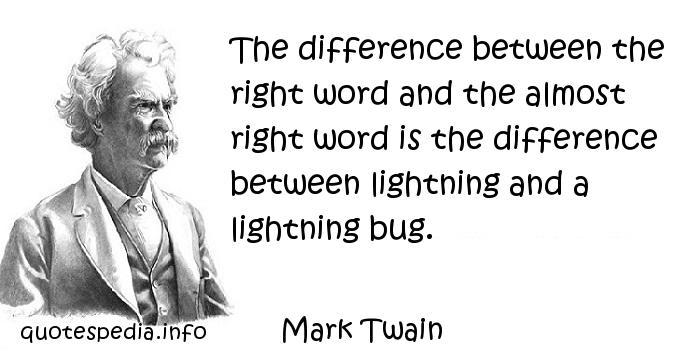Advice on writing. Part 2.
Note. Although this post is meant as a stand-alone, it might be better to read part 1 first.

By now, you know I’m also big on Mark Twain, so I might as well include his literary advice to boot. In 1885 Mr. Twain wrote an essay critical of James Fenimore Cooper titled, “Fenimore Cooper’s Literary Offenses.” It is worth the read and can be found in PDF form online. Here I include the gist of it, mainly his so called “18 offenses.” These are all from passages of Cooper’s Leatherstocking Tales, The Deerslayer, The Pathfinder and The Last of the Mohicans. The essay, which I’m sure Mr. Twain had fun writing, claims Cooper is guilty of everything from longwinded writing, pitiable plotting, obvious inconsistencies, overworked clichés, phony characterizations, and a whole gamut of similar “offenses”.
According to Wikipedia, “The essay is characteristic of Twain’s biting, derisive and highly satirical style of literary criticism, a form he also used to deride such authors as Oliver Goldsmith, George Eliot, Jane Austen, and Robert Louis Stevenson.”
Mr. Twain in his own words – as follows:
“It seems to me that it was far from right for the Professor of English Literature at Yale, the Professor of English Literature in Columbia, and Wilkie Collins to deliver opinions on Cooper’s literature without having read some of it. It would have been much more decorous to keep silent and let persons talk who have read Cooper.
Cooper’s art has some defects. In one place in “Deerslayer,” and in the restricted space of two-thirds of a page, Cooper has scored 114 offenses against literary art out of a possible 115. It breaks the record.
There are nineteen rules governing literary art in domain of romantic fiction — some say twenty-two. In “Deerslayer,” Cooper violated eighteen of them.”
These eighteen require:
1. That a tale shall accomplish something and arrive somewhere. But the Deerslayer tale accomplishes nothing and arrives in the air.
2. They require that the episodes of a tale shall be necessary parts of the tale, and shall help to develop it. But as the Deerslayer tale is not a tale, and accomplishes nothing and arrives nowhere, the episodes have no rightful place in the work, since there was nothing for them to develop.
3. They require that the personages in a tale shall be alive, except in the case of corpses, and that always the reader shall be able to tell the corpses from the others. But this detail has often been overlooked in the Deerslayer tale.
4. They require that the personages in a tale, both dead and alive, shall exhibit a sufficient excuse for being there. But this detail also has been overlooked in the Deerslayer tale.
5. They require that when the personages of a tale deal in conversation, the talk shall sound like human talk, and be talk such as human beings would be likely to talk in the given circumstances, and have a discoverable meaning, also a discoverable purpose, and a show of relevancy, and remain in the neighborhood of the subject in hand, and be interesting to the reader, and help out the tale, and stop when the people cannot think of anything more to say. But this requirement has been ignored from the beginning of the Deerslayer tale to the end of it.
6. They require that when the author describes the character of a personage in his tale, the conduct and conversation of that personage shall justify said description. But this law gets little or no attention in the Deerslayer tale, as Natty Bumppo’s case will amply prove.
7. They require that when a personage talks like an illustrated, gilt-edged, tree-calf, hand-tooled, seven-dollar Friendship’s Offering in the beginning of a paragraph, he shall not talk like a negro minstrel in the end of it. But this rule is flung down and danced upon in the Deerslayer tale.
8. They require that crass stupidities shall not be played upon the reader as “the craft of the woodsman, the delicate art of the forest,” by either the author or the people in the tale. But this rule is persistently violated in the Deerslayer tale.
9. They require that the personages of a tale shall confine themselves to possibilities and let miracles alone; or, if they venture a miracle, the author must so plausibly set it forth as to make it look possible and reasonable. But these rules are not respected in the Deerslayer tale.
10. They require that the author shall make the reader feel a deep interest in the personages of his tale and in their fate; and that he shall make the reader love the good people in the tale and hate the bad ones. But the reader of the Deerslayer tale dislikes the good people in it, is indifferent to the others, and wishes they would all get drowned together.
11. They require that the characters in a tale shall be so clearly defined that the reader can tell beforehand what each will do in a given emergency. But in the Deerslayer tale this rule is vacated.
In addition to these large rules there are some little ones. These require that the author shall:
12. Say what he is proposing to say, not merely come near it.
13. Use the right word, not its second cousin.
14. Eschew surplusage.
15. Not omit necessary details.
16. Avoid slovenliness of form.
17. Use good grammar.
18. Employ a simple and straightforward style.
mt

